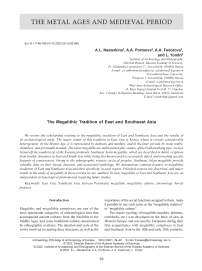The megalithic tradition of East and Southeast Asia
Автор: Nesterkina A.L., Portnova A.A., Fedorova A.A., Yondri L.
Журнал: Archaeology, Ethnology & Anthropology of Eurasia @journal-aeae-en
Рубрика: The metal ages and medieval period
Статья в выпуске: 3 т.50, 2022 года.
Бесплатный доступ
We review the scholarship relating to the megalithic tradition of East and Southeast Asia and the results of its archaeological study. The major center of this tradition in East Asia is Korea, where it reveals considerable heterogeneity. In the Bronze Age, it is represented by dolmens and menhirs, and in the later periods by stone tombs, chambers, and pyramidal mounds. The latest megaliths are anthropomorphic statues of the Dolhareubang type, on Jeju Island off the southern tip of the Korean peninsula. Southeast Asian megaliths, which are described in detail, originate from similar structures in East and South Asia while being less known and less accurately dated, and revealing specific features of construction. Owing to the ethnographic sources on local peoples, Southeast Asian megaliths provide valuable data on their layout, function, and associated mythology. We demonstrate common features in megalithic traditions of East and Southeast Asia and their specificity in each region. Principal sources are described, and major trends in the study of megaliths in those territories are outlined. In sum, megaliths of East and Southeast Asia are an independent archaeological phenomenon requiring future studies.
East Asia, Southeast Asia, Korean Peninsula, megaliths, megalithic culture, chronology, burial practice
Короткий адрес: https://sciup.org/145146800
IDR: 145146800 | DOI: 10.17746/1563-0110.2022.50.3.039-048
Текст научной статьи The megalithic tradition of East and Southeast Asia
Megaliths and megalithic complexes are one of the most spectacular categories of archaeological sites that accompanied ancient cultures from the Neolithic to the Middle Ages, and some traditional cultures documented by ethnographic evidence. The duration and scale of the works involved in creating these structures, as well as the importance of the social functions assigned to them, make it possible to use such terms as the “megalithic tradition” or “megalithic culture”.
The classic typology of megaliths (menhirs, dolmens, cromlechs, etc.) was developed on the basis of sites in Western Europe, and was used by Europeans during their first acquaintance with megalithic complexes in East and Southeast Asia in the 18th and early 20th centuries.
Further research revealed a much greater typological and functional diversity of structures with megalithic features, and proved the need for detailed study of this phenomenon.
In the Russian archaeology, there is some experience in analyzing megalithic complexes of the Bronze Age on the Korean Peninsula, the Jomon period in Japan, and sites of various periods in Indonesia on the Islands of Java and Bali (Nesterkina et al., 2017; Tabarev, Gavrilina, 2020; Tabarev et al., 2017). This experience fosters the study of the megalithic traditions in individual cultures, periods, and regions of East and Southeast Asia for clarifying their common and local features.
This article provides an overview of the sources, main results, and promising areas of research on megaliths in East and Southeast Asia. To study the whole variety of

Fig. 1 . Megalithic complexes on the Korean Peninsula. 1 – early megaliths (the dolmen culture); 2 – mound and under-mound complexes with megalithic features; 3 – anthropomorphic Dolhareubang statues.
manifestations of the megalithic culture in East Asia, we need to consider the structures in Korea as the largest center of megalithic culture in that region.
The megalithic tradition of Southeast Asia (Vietnam, Laos, Cambodia, Indonesia, Philippines, and Malaysia) shows constructive-typological and functional diversity of structures. Therefore, to achieve its goal, this article will discuss the most important structures and complexes, and show that the Korean megalithic culture, which has been considered relatively homogeneous until now, has significant chronological and morphological variability, and finds some parallels in Southeast Asia.
Description of megalithic structures
Korean Peninsula
The megalithic tradition in East Asia flourished in the Bronze Age (10th–3rd centuries BC), when the Korean Peninsula became its main area (Li Yonmun, 2002: 258–260). According to preliminary data, over thirty thousand megalithic structures are concentrated there on a rather compact territory. The centers of the megalithic culture in Korea are Ganghwa Island in the west, and South Jeolla Province in the southwest (Fig. 1), although megaliths occur almost everywhere. The megaliths of the Korean Peninsula include dolmens and menhirs (Hanguk jiseokmyo …, 1999: 1203).
Although Korean dolmens are heterogeneous, differences in their structures do not imply chronological significance, since structures of several types often appear at the same site (Hado-ri on Ganghwa Island, Juklim-ri and Sanggap-ri in Geochang County, etc.). Along with classic dolmens (Fig. 2), the peninsula also has “nonclassic” structures in the form of stone slabs and boulders, sometimes resting on low supporting stones (Fig. 3). Beneath some of the slabs, stone boxes or earthen pits have been discovered, which in rare cases contained the remains of the deceased. Korean scholars consider all dolmens on the peninsula to be burial sites (Hanguk jiseokmyo yeongu …, 2000: 9, 256, 261).
Anthropological evidence related to dolmens is scarce, so the question of the purpose of Korean megaliths is still open. It can be assumed that not all dolmens were burial structures. Some might have had a ritual and commemorative function, serving as centers for collective rituals of community, as is indicated by numerous pottery fragments associated with dolmens. The usual scarce burial goods of Korean megaliths provide little information about time of their creation, so the objects were dated to a wide chronological period in the Bronze Age.
The dating of the dolmens on Jeju Island deserves special attention. Since the island is located off the southeastern coast of the Korean Peninsula, far from the
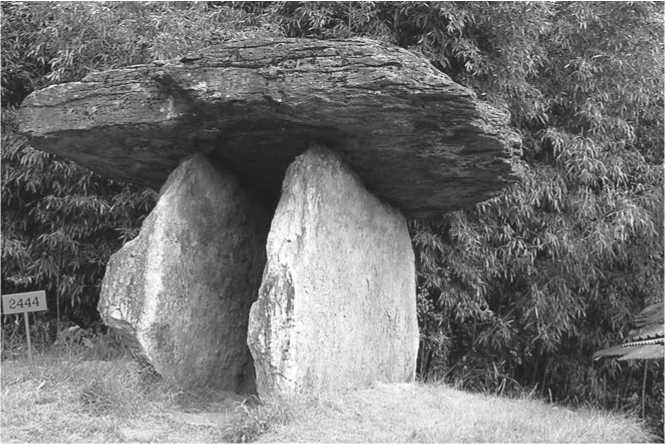
Fig. 2 . Dolmen Dosan-ri in Geochang, North Jeolla Province, Republic of Korea. 2006. Photo by A.L. Nesterkina .
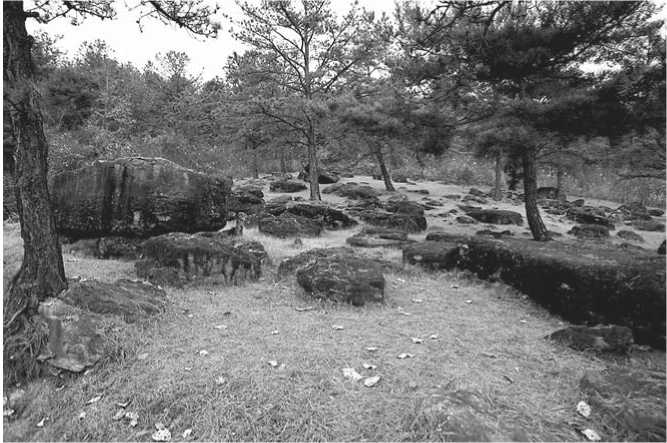
Fig. 3 . Dolmens Hyosan-ri and Daesin-ri in Hwasun County, South Jeolla Province, Republic of Korea (Hwasun Hyosan-ri-wa…, 2015: Fig. 8).
main cultural and historical centers on the mainland, it is generally believed that many elements of traditional Korean culture were preserved on the island for a relatively long time, and dolmens functioned there until the Early Iron Age, longer than those on the peninsula (Ibid.: 139–140).
In the subsequent periods of the Iron Age and Middle Ages, megalithism manifested itself in the construction of mounds and under-mound structures, such as tombs, chambers, and pyramidal mounds (Seong Jeongyong, Seo Hyeonju, 2007: 261–270) (see Fig. 1). Notably, the anthropomorphic Dolhareubang sculptures have been discovered only on Jeju Island. These objects are fullsize (1.3–1.8 m high) human-like statues (see Fig. 1, 4). There are forty-five such sculptures on Jeju Island. It is difficult to establish the exact time of their creation; historical sources mention their existence on the island in the 18th century. Thus, it can be concluded that individual elements of the megalithic tradition that originated in Korea during the Bronze Age have survived in some of its regions until the ethnographically modern period (Hwang Si-Kwon, 2019: 45–48).
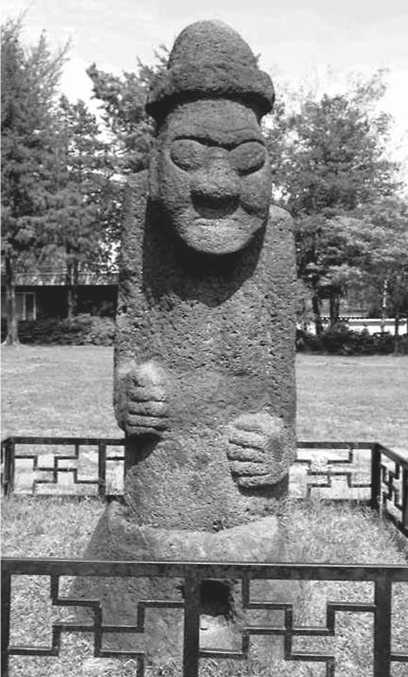
Fig. 4 . Dolhareubang statue (Hwang Si-Kwon, 2019: Fig. 8).
Continental and insular parts of Southeast Asia
The earliest manifestations of the megalithic culture in Laos include menhirs and chambers (3rd–1st millennium BC) in the northeast of the country, in Huaphan, Luang Namtha, Luang Prabang, Xienghuang, Sankongfan, and Keohintang provinces (Fig. 5). An important site is the complex, dating to the turn of the eras, called the “Plain of Jars” in Xienghuang Province. Over a thousand locations with three thousand megalithic urns have been discovered in its territory.
The “jars” of Laos were first mentioned by J. McCarthy (1888). In the 1930s, M. Colani conducted extensive archaeological research in the area. She cataloged and described nearly ten thousand megaliths, and proved the connection between stone urns and funerary rites (Colani, 1930). In the 21st century, archaeological excavations were continued at the site; its boundaries, as well as the number and degree of preservation of the objects, were clarified (Bergh, van den, 2008; Baldock, Bergh, van den, 2009).
A serious problem in the study of the stone urns is establishing their age. The most reliable date seems to be 500 BC–800 AD, which corresponds to the Sa Huỳnh archaeological culture, which area extended from the Mekong delta to the south of the Tonkin region (Colani, 1930).
In the north of Laos, the Hintang archaeological park is located, with 1500 vertically set flat menhir stones
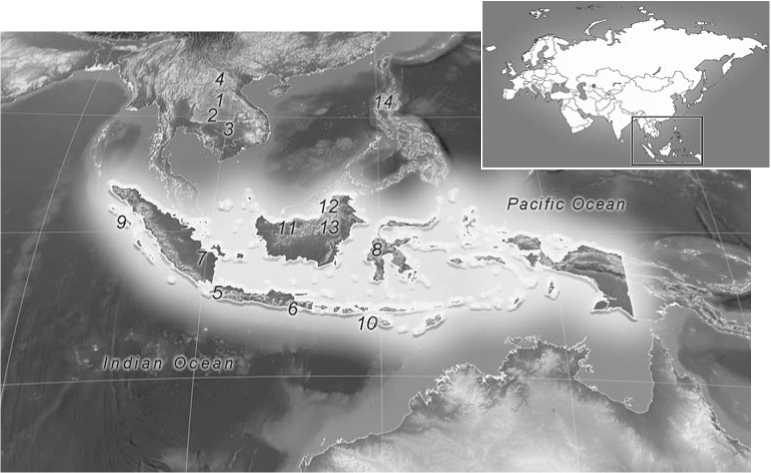
Fig. 5 . Areas of megalithic complexes mentioned in this article in the continental and insular parts of Southeast Asia.
1 – Hintang, Laos; 2 – “Plain of Jars”, Laos; 3 – Prasat Thom, Cambodia; 4 – Sa Pa, Vietnam; 5 – West Java, Indonesia; 6 – East Java, Indonesia; 7 – Pasemah, Indonesia; 8 – Bada Valley, Indonesia: 9 – Nias Island, Indonesia; 10 – Sumba Island, Indonesia; 11 – Sarawak Province, Malaysia; 12 – Sabah Province, Malaysia;
13 – North Kalimantan Province, Indonesia; 14 – North Luzon, Philippines.
reaching 3 m high, with large stone slabs covering gravepits between the menhirs. The Hintang megalithic culture, like the Plain of Jars, was dated to the Bronze Age (3rd– 2nd millennium BC) (Higham, 1989). On the basis of the evidence from excavations in Hintang Park, Colani suggested that the menhirs were associated with burial ceremonies, since ceramic burial urns were found in the pits (1930).
In Vietnam and Cambodia, only few classic megaliths are known. Notable archaeological sites in Cambodia include pyramidal temples made of brick and laterite: Baksei Chamkrong, Prasat Thom, etc.
The first studies of megaliths in Vietnam were carried out in 1927 (Bouchot, 1927). Various complexes have been discovered at Hang Gon (Fig. 6), Dong Pho, Chu Pa, Lam Kha, Vu Xa, Kim Boi, Tam Dao, Thien Ke, Nam Dan, Ban Thanh, Mau Son, Ta Van Giay, and Soc Son. M. Colani and L.M. Cadière studied the general attitude of the peoples of Vietnam towards stones. Describing medieval terracotta statues in the Thu Bon valley, Colani observed many cults of spiritual stones called “But” (the predecessors of the later “Kut”)—decorated stones “coming out of the earth” (Cadière, 1911).
Noteworthy is the Sa Pa complex, discovered in 1925 in Northern Vietnam. It consists of stones with petroglyphs (Goloubew, 1929) and includes about two hundred stones, the largest of which is 15 m long and 6 m high. The subjects of the petroglyphs are diverse and include people, stilt-houses, and ritual symbols.
Megalithic structures in Indonesia have been known since 1842, when first descriptions of terraced rice-fields with the vertically set menhir stones in Salakdatar in West Java Province appeared (Soejono, 1969). Later, dolmens and stone sarcophagi were discovered in Eastern Java, stone sculptures in Sumatra (Pasemah Plateau), and urns and anthropomorphic sculptures in the Bada Valley on Sulawesi (Raven, 1926; Kruyt, 1932; Sarasin P., Sarasin F., 1905). There is information on megaliths on the small islands of the Indonesian Archipelago, such as Bali, Flores, Nias, Sumba, etc. (Fig. 7).
Some hypotheses have been proposed concerning the origin and time when these stone structures were created. R. Heine-Geldern suggested that megaliths appeared in Indonesia as a result of two waves of migration. Representatives of the first, Neolithic, wave 4500– 3500 BP left mainly menhirs, dolmens, and stone terraces, while the second wave, corresponding to the Bronze and Early Iron Ages ca 2500 BP left stone sarcophagi, funerary urns, and tombs (Heine-Geldern, 1928). However, most of the accompanying archaeological evidence (iron and gold items, glass beads, Chinese porcelain), as well as radiocarbon dates, point to a later period from the 7th to the 16th century AD, which gave some scholars grounds to associate the construction of these objects with Indo-Buddhist influence. Indonesian
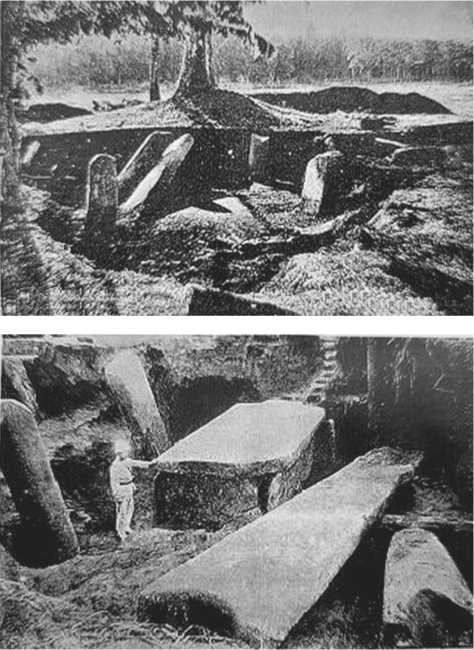
Fig. 6 . Megalithic complex in Hàng Gòn, Vietnam (Bouchot, 1927: Ill. 10).
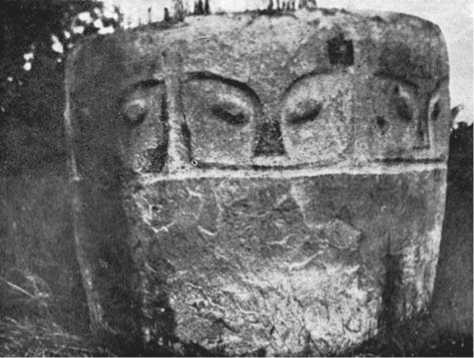
Fig. 7 . Stone urn in the Bada Valley, Sulawesi, Indonesia (Heeckeren, van, 1958: Ill. 22).
archaeologists attribute the appearance of megaliths to the Final Neolithic ca 2500 BP (Steimer-Herbet, Besse, 2017).
Megaliths on Nias Island in the Gomo region were made not for burying the dead in them, but for indicating their social status. According to narrative tradition, all ancestral stories refer to the progenitor known as Hia
Walani Adu. He initiated the ceremony of erecting stone monuments (Duha, 2012; Pramaresti, 2018) associated with holding intergroup festivities, during which the representatives of the tribal elite distributed treats to all participants (Beatty, 1992; Feldman, 1988).
Megalithic heritage on Sulawesi Island is concentrated in the areas of Napu, Besokha, and Bada. Stone sculptures and huge cylindrical urns with massive lids are the most common type of object (Heeckeren, van, 1958). Analysis of the contents of the urns has shown the presence of only ashes and pottery fragments (Raven, 1926).
The anthropomorphic sculptures include both male and female figures with hypertrophied sexual characteristics. The face was rendered in a distinctive manner. Two handles on the sides of the head represent the ears; nose is straight; the bridge of the nose extends to the eyebrows; there is no mouth (except for one item found in the Bada Valley); the eyes are round, protruding, or slanting (Heeckeren, van, 1958).
Numerous megalithic tombs have been discovered on Sumba Island. The first information about them is contained in the works of R. Heine-Geldern (1936), G.P. Rouffaer (1937), H.G. Keith (1947), and A.N.J. van der Hoop (1932). Modern studies describe some regularities in the arrangement of tombs (see, e.g., (Steimer-Herbet, 2018)).
The monuments of megalithic culture appear widely on the Island of Java. Over two hundred sites with megaliths have been found in West Java Province alone. In 2019, West Java Province was visited by Russian scholars, who examined megalithic monuments of various types, including complexes with vertically set stones, pyramidal structures, and tiered monumental structures (Tabarev, Gavrilina, 2020) (Fig. 8).
Borneo/Kalimantan is the third largest (743,330 km2) island in the world. It is currently divided between three countries—Brunei, Indonesia, and Malaysia. Targeted studies of megaliths have been carried out since the 1920s, predominantly in the Malaysian part in Sarawak and Sabah Provinces. Scholars have reported the presence of various megaliths, including menhirs (single and paired up to 1.0–1.2 m high), stone urns, bas-reliefs, as well as natural rocks and boulders of unusual
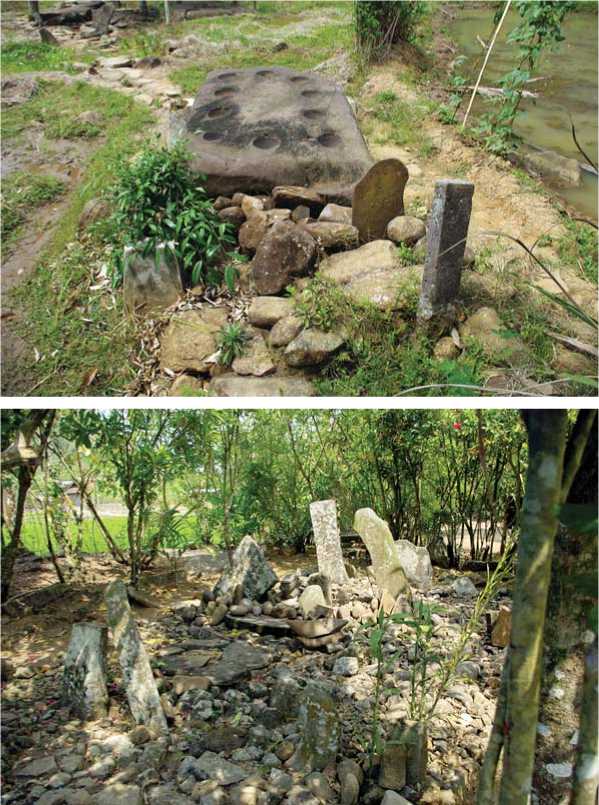
shapes with ritual symbols among the Kelabit people (Banks, 1937; Mjöberg, 1925), and studied anthropomorphic sculptures and stones, set vertically inside and around settlements for protection against disease and epidemics (Evans, 1923).
The British explorer T. Harrisson made the greatest contribution to the study of megaliths in the Malaysian part of the island. His works provide detailed information about the geographical areas of megalithic objects, as well as their number and diversity (Fig. 9). According to the observations of Harrisson, “megalithic activity” was an integral part of ritual practices and accompanied the most important events, such as feasts, weddings, and funerals. It was associated with the cultures of the Metal Age (first centuries of our era) and the cultures of historical time (starting from the 13th– 14th centuries) (Harrisson, 1970, 1973; Harrisson, O’Connor, 1970).
Systematic study of megaliths in the vast Indonesian territory of Borneo has been carried out since the 1990s by French scholars in the Bahau River basin (North Kalimantan Province) (Arifin, Sellato,
Fig. 8 . Megalithic complexes in West Java Province, Indonesia. Photo by A.V. Tabarev .
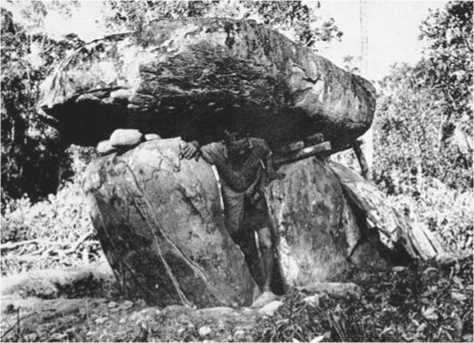
Fig. 9 . Dolmen in Sarawak Province, Malaysia (Harrisson, 1973: Ill. 1).
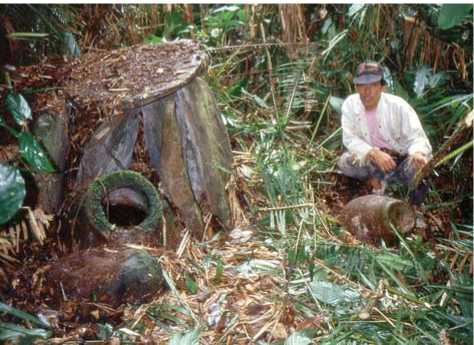
Fig. 10 . Dolmen with funeral urn, Kalimantan. Photo by B. Sellato .
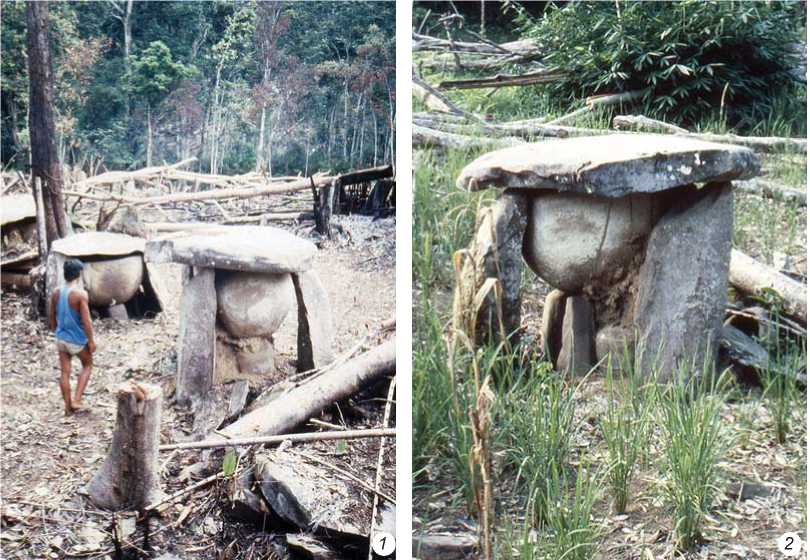
Fig. 11 . Dolmens with funeral urns, Kalimantan. Photo by B. Sellato .
1 – group of dolmens; 2 – single dolmen with a child burial.
2003). The researchers have discovered a large number of megalithic complexes created by the Ngorek group, which inhabited this territory in the first half of the 18th century.
Most of the megaliths are associated with funeral rituals and consist of the so-called dolmens with urns— structures of several vertically set stones 1.5–2.0 m high, covered with a horizontal slab (Fig. 10). Stone or ceramic urns up to 1 m high with the remains of the dead were placed inside these structures (Fig. 11, 1). There are also miniature dolmens 0.2–0.4 m high, containing children’s burials (Fig. 11, 2). Sandstone used for manufacturing megaliths was processed exclusively with polished adzelike basalt tools (Sellato, 2016).
Other types of megaliths include rectangular funerary sarcophagi, steles with anthropomorphic and zoomorphic images in relief, and individually standing menhirs. A specific variant (the aso tradition) are huge (up to 30 m long) figures of real (crocodile) and mythological (dragon) animals made of earth and stones, which play the role of psychopomps (creatures accompanying the souls of the dead to the afterlife) and at the same time serve as symbols of fertility (Schneeberger, 1979).
In the Philippines , no classic menhirs, dolmens, or cromlechs have been found. The common opinion is that in the Philippines the megalithic culture is very poorly represented, if not absent entirely (Beyer, 1948). Nevertheless, in the traditional culture of the local population, among the representatives of the Igorot ethnic groups in the mountainous regions in the north of Luzon Island, a number of public buildings and elements of agricultural systems made of stone are known, which fully correspond to the concept of “megalithic culture”. The first type is dap-ay —an open area lined with stone slabs, with a hearth in the middle; it was a variant of the “men’s house”, where various problems in the life of community were solved. Some dap-ay are outlined with vertically set stone slabs reaching 2 m high; large river-boulders were placed as benches along the inner perimeter (Heine-Geldern, Vanoverbergh, 1929; Jensen, 1960; Evangelista-Leones, 2004). There is information on several tombs with “stone domes” among the Ifugao groups (Lambrecht, 1938). The second type is associated with the practice of large-scale modification of mountainous terrain; these are the Ifugao rice-terraces (included in the UNESCO World Cultural Heritage List). The edges of the terraces were reinforced with walls made of large stones going into the ground to a depth of 2 m. The amount of material and labor-costs during the construction of the walls was comparable to the construction of the Egyptian pyramids; therefore, they are traditionally considered as megalithic and monumental complexes (Beyer, 1955). Initially, the terraces were attributed to the 3rd–2nd millennia BC; but later, on the basis of research including radiocarbon dating, it was discovered that creation of various structural elements began in the 15th–17th centuries (Acabado, 2009).
Conclusions
The megalithic culture of East and Southeast Asia is a unique yet morphologically and chronologically heterogeneous phenomenon.
Although Korean megaliths of the Bronze Age, represented by dolmens, have been sufficiently well studied, studies aimed at identifying the diversity of both early Korean megaliths (dolmens) and later manifestations of megalithism (elements of burial mounds and undermound structures) seem promising. An important task, of not only archaeological but also historical and ethnographic research should be clarification of the time when the Dolhareubang anthropomorphic statues on the Island of Jeju appeared.
Considering the subject of megalithic traditions, research on the continental and insular parts of Southeast Asia is promising. The megalithic traditions of this region, related in their origin to those of the adjacent regions of
East and South Asia, show a number of peculiarities, such as degree of study resulting from the difficulty of detecting and analyzing the complexes, specific structural aspects, and problems of dating. However, precisely the megaliths of Southeast Asia make it possible to trace the specific details of their construction, as well as the purpose and mythological accompaniment of the complexes thanks to the ethnographical data of the local peoples. Research based on archaeological and ethnographic approaches will be especially productive. In this regard, it is important to use the huge information capacity of publications on the initial period of studying the megaliths (18th–first half of the 20th century), which provide descriptions of the rituals and ceremonies associated with the megaliths, as well as photographs and sketches of objects that have been partially or completely destroyed by now. All this presupposes active international cooperation between archaeologists and ethnographers, aimed at studying Asian megaliths.
Acknowledgments
This study was carried out in equal shares: by A.L. Nesterkina and A.A. Fedorova under the grant supported by the Russian Science Foundation, Project No. 22-28-00566; by A.A. Portnova under the graduate qualifying project; by L. Yondri under the individual scientific research. The authors are grateful to Dr. A.V. Tabarev from the Institute of Archaeology and Ethnography of the SB RAS and Dr. B. Sellato from the CNRS for their help in finding literature and illustrations on the topic of the article and for their valuable comments.
Список литературы The megalithic tradition of East and Southeast Asia
- Acabado S. 2009 A Bayesian approach to dating agricultural terraces: A case from the Philippines. Antiquity, vol. 83: 801-814.
- Arifin K., Sellato B. 2003 Archaeological survey and research in four districts of Interior East Kalimantan. In Social Science Research and Conservation Management in Interior Borneo: Unraveling Past and Present Interactions of People and Forests. Jakarta: Center for Intern. Forestry Research, pp. 201-241.
- Baldock J., Bergh J., van den. 2009 Geological mysteries of the plain of jars begin to unravel. Geology Today, vol. 25 (4): 145-150.
- Banks E. 1937 Some megalithic remains from the Kelabit country in Sarawak with some notes on the Kelabits themselves. Sarawak Museum Journal, vol. 4: 411-438.
- Beatty A. 1992 Society and Exchange in Nias. Oxford: Clarendon Press.
- Bergh J., van den. 2008 Safeguarding the plain of jars, an overview. Recherches Nouvelles Sur Le Laos. In New Research on Laos. Vientiane, Paris: École française d’Extrême Orient, pp. 65-80.
- Beyer H.O. 1948 Philippine and East Asian archaeology, and its relation to the origin of the Pacifi c islands population. Bulletin of the National Research Council of the Philippines, No. 29: 1-130.
- Beyer H.O. 1955 The origin and history of the Philippine rice terraces. In Proceedings of the Eighth Pacific Science Congress of the Pacific Science Association, 16-28 November 1953, vol. 1. Quezon City: Univ. of the Philippines, pp. 387-397.
- Bouchot J. 1927 Les Fouilles (des Xuan Loc). Bulletin de la Société des études indochinoises, No. 2: 155-156.
- Cadière L.M. 1911 Le culte des pierres en Annam. Missions Catholiques, vol. 63 (2209-2218): 158-172.
- Colani M. 1930 The megaliths of Upper Laos. Paris: École française d’Extrême-Orient.
- Duha N.A. 2012 Omo Niha: Perahu Darat di Pulau Bergoyang. Gunungsitoli: Nias Heritage Foundation.
- Evangelista-Leones S. 2004 The Bontok Igorot tribe: An internal scanning of its governance system. Philippine Journal of Public Administration, vol. XLVIII (1/2): 86-123.
- Evans I.H.N. 1923 Studies in religion, folk-lore and custom in British North Borneo and the Malay Peninsula. Cambridge: Cambridge Univ. Press.
- Feldman J. 1988 The seat of the ancestors in the homeland of the Nias People. In Islands and Ancestors: Indigenous Styles of Southeast Asia. New York: The Metropolitan Museum of Art, pp. 33-49.
- Goloubew V. 1929 L’âge du Bronze au Tonkin et dans le Nord-Annam. Bulletin l’École française d’Extrême-Orient, vol. 29: 1-46.
- Hanguk jiseonmyo (goindol) yujeok jonghap josa yeongu: Bunpo, hyeongsik, giwon, jeonpa mit sahoebogwon [Complex Study of Korean Dolmens: Distribution, Typology, Origins, Relations and Social Reconstruction]. 1999 Seoul, Munhwajaecheong [Cultural Heritage Administration of Republic of Korea], Seoul Daehakkyo banmulgwan [Seoul National University Museum]. (In Korean).
- Hanguk jiseonmyo yeongu iron-gwa bangbeop: gyegeupsahoeui balsaeng [Theories and Methods of Dolmen Research in Korea: Emergence of Stratifi ed Societies]. 2000 Seoul, Juryuseong: (In Korean).
- Harrisson T. 1970 The prehistory of Borneo. Asian Perspectives, vol. XIII: 17-45.
- Harrisson T. 1973 Megalithic evidences in East Malaysia: An introductory summary. Journal of the Malaysian Branch of the Royal Asiatic Society, vol. 46 (1): 123-139.
- Harrisson T., O’Connor S.J. 1970 Gold and Megalithic Activity in Prehistoric and Recent West Borneo. Ithaca, New York: Cornell Univ. Southeast Asia Program.
- Heeckeren H.R., van. 1958 The Bronze-Iron Age of Indonesia. S-Gravenhage: Martinus Nijhoff.
- Heine-Geldern R. 1928 Die Megalithen Südostasiens und ihre Bedeutung für die Klärung der Megalithenfrage in Europa und Polynesien. Anthropos, vol. XXIII: 276-315.
- Heine-Geldern R. 1936 Prehistoric research in Indonesia. Annual Bibliography of Indian Archaeology, No. 13: 26-38.
- Heine-Geldern R., Vanoverbergh P.M. 1929 Der Megalithkomplex auf der Philippinen-Insel Luzon. Anthropos, vol. 24 (1/2): 317-321.
- Higham Ch. 1989 The archaeology of Mainland Southeast Asia: From 10,000 B.C. to the fall of Angkor. Cambridge: Cambridge Univ. Press.
- Hoop A.N.J., van der. 1932 Megalithic Remains in South Sumatra. Zutphen: W.J. ThiemeʼCie.
- Hwang Si-Kwon. 2019 Jeju dolhareubang-ui jejak sigi gochal [A Study on the Production Time of Dolhareubang (Totem pole) in Jeju Island]. Tamra munhwa [Tamra culture], No. 61: 45-94. (In Korean).
- Hwasun Hyosan-ri-wa Daesin-ri jiseokmyo gun [Dolmens in Hyosan-ri and Daesin-ri, Hwasun]. 2015 URL: https://www.heritage.go.kr/heri/cul/culSelectDetail.do?VdkVgwKey=13,04100000,36&pageNo=1_1_1_0. (Accessed March 13, 2022). (In Korean).
- Jensen A.E. 1960 Feld-Terrassen und Megalithen. Eine Skizze. Paideuma, vol. 7 (4-6): 258-373.
- Keith H.G. 1947 Megalithic remains in North Borneo. Journal of the Malayan Branch of the Royal Asiatic Society, vol. 20 (1): 153-155.
- Kruyt A. 1932 L’immigration préhistorique dans les pays des Toradjas occidentaux. Hommage du Service Archéologique des Indes Néerlandaises au Premier congrès des préhistoriens d’ExtrêmeOrient, vol. 2: 1-15.
- Lambrecht F. 1938 The Mayawyaw ritual. Publications of the Catholic Anthropological Conference, No. 3: 327-493.
- Lee Young Moon. 2000 Hanguk jiseonmyo sahoe yeongu [Korea Dolmen Society Research]. Seoul: Hagyeong Munhwasa. (In Korean).
- McCarthy J.F. 1888 Siam. Proceedings of the Royal Geographical Society and Monthly Record of Geography. New Monthly Ser., No. 10/3: 117-134.
- Mjöberg E. 1925 An expedition to the Kalabit country and Mt. Murud, Sarawak. Geographical Review, vol. 15 (3): 411-427.
- Nesterkina A.L., Solovyeva E.A., Tabarev A.V., Ivanova D.A. 2017 The megaliths of Korea and Japan: An analysis of origins and functions. Archaeology, Ethnology and Anthropology of Eurasia, vol. 45 (3): 106-114.
- Pramaresti E.W. 2018 Perkembangan Ragam Hias Pada Omo Sebua di Nias Selatan, Sumatera Utara. Majalah Arkeologi, vol. 27 (2): 80-88.
- Raven H.C. 1926 The stone images and vats of Central-Celebes. Natural History, No. 26: 272-282.
- Rouffaer G.P. 1937 Ethnographie van de kleine Soenda Eilanden in Beeld. S-Gravenhage: Nijhoff.
- Sarasin P., Sarasin F. 1905 Reisen in Celebes. Wiesbaden: S.W. Kriedel’s Verlag.
- Schneeberger W.F. 1979 Contributions to the ethnology of Central Northeast Borneo (parts of Kalimantan, Sarawak and Sabah). Studia Ethnologica Berniensia, vol. 2.
- Sellato B. 2016 The Ngorek of the central highlands and “megalithic” activity in Borneo. In Mégalithismes Vivants et Passés, Approches Croisées. Living and Past Megalithisms: Interwoven Approaches. Oxford: Archaeopress Archaeology, pp. 117-150.
- Seong Jeongyong, Seo Hyeonju. 2007 Baekje [Baekje culture]. In Hanguk gogohak gangue [Lectures on Korean Archaeology]. Seoul: Sahoe Pyeongnon, pp. 255-300. (In Korean).
- Soejono R.P. 1969 The history of prehistoric research in Indonesia to 1950. Asian Perspectives, No. 12: 69-92.
- Steimer-Herbet T. 2018 Indonesian Megaliths: A Forgotten Cultural Heritage. Oxford: Archaeopress Archaeology.
- Steimer-Herbet T., Besse M. 2017 Indonesian megaliths as the result of the interaction between indigenous peoples and Hindu-Buddhist kingdoms. In Austronesian Diaspora. A New Perspective. Proceedings of the International Symposium on Austronesian Diaspora (18th-23rd July 2016, Nusa Dua, Bali, Indonésie). Gadjah Mada University Press: pp. 301-318.
- Tabarev A.V., Gavrilina T.A. 2020 Megaliticheskiye kompleksy tropicheskoy chasti tikhookeanskogo basseyna: Indoneziya. Teoriya i praktika arkheologicheskikh issledovaniy, No. 1: 152-165.
- Tabarev A.V., Ivanova D.A., Nesterkina A.L., Solovyeva E.A. 2017 The Jomon megalithic tradition in Japan: Origins, features, and distribution. Archaeology, Ethnology and Anthropology of Eurasia, vol. 45 (4): 45-55.

